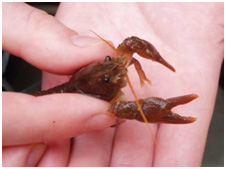 The one year old crayfish, reared at the Agency’s fish hatchery near Brecon, have been released into a carefully selected site on the river to breed andwere released in conjunction with the Wye and Usk Foundation, as part of the European Union’s Life+ funded Irfon Special Area of Conservation Project (ISAC).
The one year old crayfish, reared at the Agency’s fish hatchery near Brecon, have been released into a carefully selected site on the river to breed andwere released in conjunction with the Wye and Usk Foundation, as part of the European Union’s Life+ funded Irfon Special Area of Conservation Project (ISAC).
Work to reintroduce crayfish into the area began in 2009, when egg carrying females were caught and transported to the hatchery from selected wild populations. After a year in captivity the juvenile crayfish are stocked into carefully selected ‘Ark’ sites. These sites are chosen for their good habitat and water quality and because they are free from non-native crayfish and crayfish plague, a lethal fungus-like disease.
Oliver Brown, from Environment Agency Wales, said:
“This project is an essential part of the Agency’s crayfish conservation strategy which involves protecting existing populations and establishing new safe havens for the species.
Working with the Wye and Usk Foundation has allowed us to develop our rearing facilities so we can release larger numbers of this threatened species back into the wild to help ensure its survival.”
Simon Evans, from the Wye and Usk Foundation and Project Manager of ISAC said:
“This work provides a beacon of hope for our native crayfish and is part of our efforts to improve the Irfon catchment as a whole.
We are also recovering the river’s habitat and water quality that the introduced crayfish need to thrive”
The White-claw is Britain’s only native crayfish. It is under threat from disease, climate change, habitat degradation and competition from the more aggressive American Signal crayfish. Their status has recently been elevated from threatened to endangered and experts believe that without intervention there is real risk of the species becoming extinct from mainland Britain within the next three decades.
This project is a small part of the wider work taking place to mitigate for the many threats facing the White-clawed crayfish. Elsewhere, water quality and habitats are being restored to a condition suitable for them and the invasive Signal crayfish are being controlled.










